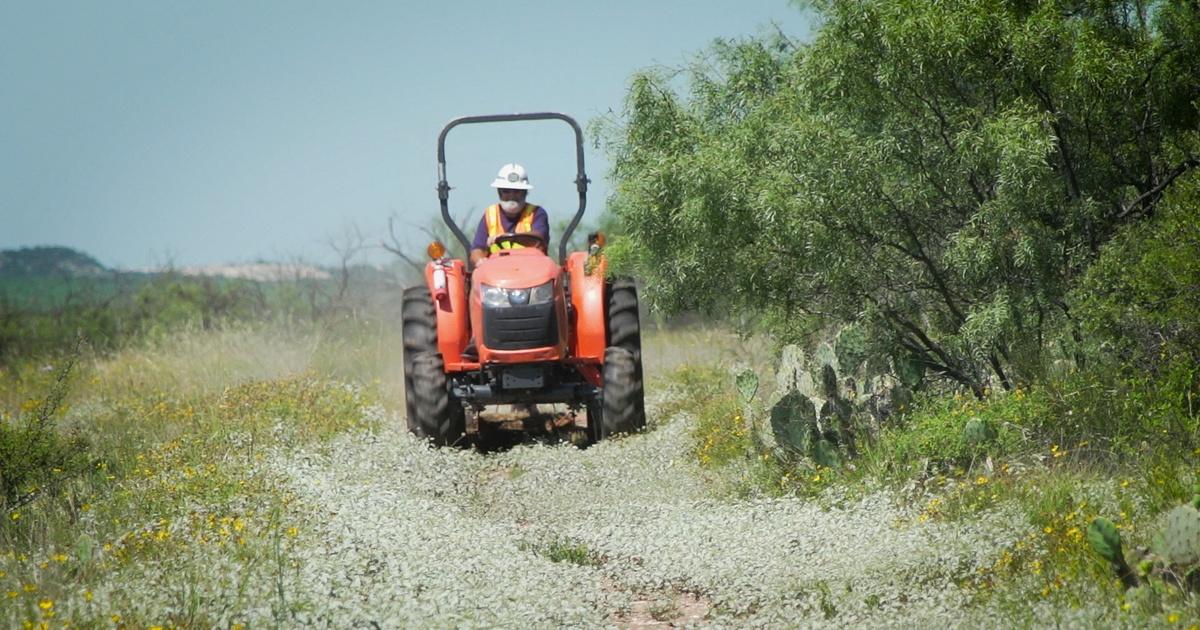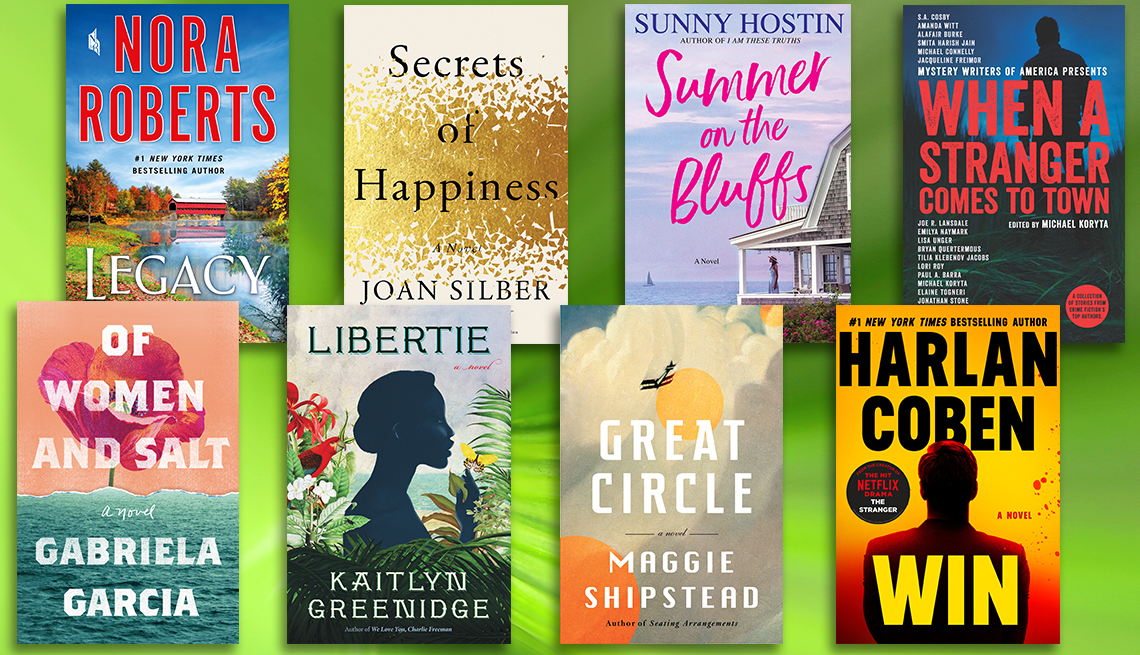
- Select a language for the TTS:
- UK English Female
- UK English Male
- US English Female
- US English Male
- Australian Female
- Australian Male
- Language selected: (auto detect) - EN
Play all audios:
- ANNOUNCER: The Texas Parks and Wildlife Television Series is supported in part by Texas Parks and Wildlife Foundation -- conserving the wild things and wild places of Texas, thanks to
members across the state. Additional funding is provided by Toyota. Your local Toyota dealers are proud to support outdoor recreation and conservation in Texas. Toyota -- Let's Go
Places. - NARRATOR: Coming up on Texas Parks & Wildlife... - The actual single-track is about 30 miles, a lot more than most of the parks in Texas have. - It's been in the family
since 1888 when my grandfather bought the first section. - It's kind of a dance. We've built so many towers together, we very seldom even speak while we're constructing.
[theme music] ♪ ♪ - NARRATOR: Texas Parks and Wildlife, a television series for all outdoors. [metal door clanging] - This is the hanger where I do all of my car projects. [mellow music]
This is a 73 Karmann Ghia convertible... and there's the motor. [laughs] This is an 82 De Lorean. I'm John Talley. I'm a European auto technician. When I first moved out here,
they really needed people to work on Volkswagens. And it's kept me really, really busy for 40 years. So this is how I spend some of my days. I moved out here in 78. We're just
really, really lucky that out here we've got this heaven right outside of town. [mellow music] - JIM CISNEROS: There's not much that I suspect John Talley can't do. I've
only been here a couple of years, but from what I understand, John's been here from the very beginning. - JOHN: A lot of the places are growing up and getting urbanized. I enjoy being
out here all by myself, but I'm always amazed how many people in town don't know this piece of heaven is right here. [mellow music] - JIM: We're off the beaten path in Texas.
I think we're the biggest city that doesn't have an interstate running through it. [water flowing] We get some of the hills from the Hill Country. We get some of the desert stuff
from the Chihuahuan Desert Plateau. You're out here, and you feel like you're in the wilderness, but we're literally a few miles from town. [car door] - JOHN: In five or ten
minutes they can be here and enjoy it. Riding a bicycle, or boating, or hiking or whatever. Pretty much just wake up each day and decide if I'm going to go out and ride the bike or work
on somebody's car, or I'm going to get on a tractor and mow the trails. [tractor starts] I take care of the trails at the San Angelo State Park. [footsteps] This is the area that
we call Little Foot Draw because some, I call it a dinosaur, came walking through here at some point in time and left these footprints, preserved in this creek bed. That's pretty
amazing right there. These have been here for many, many, many years, before man was even considered. This is a place where you can just stop and think. [guitar music] When you see them
along this ridge over here, it's kind of like getting a picture of the Old West. People from out of town come to see the bison and our longhorn. This is part of the official Texas state
herd. This is one of my favorite things to come out here and I really feel like I'm in another time sequence. [guitar music] - JIM: I think it's the variety of activities that you
can do out here. Pretty close to 8,000 acres. And I tell my volunteers this all the time. I can't run this park without you. - JOHN: Tractors and the lawnmowers, sometimes they'd
break down in middle of the park and I'd go out and get them running again. Do minor repairs on the Coke machines. And now we have a new firewood vending machine. So I keep all that
going. [clanking] - JIM: He's like a Renaissance man. Sometimes it's helping us diagnose a mechanical problem, sometimes mowing the trails, but when I first got here, John invited
me to one of his gigs. And I was like, "You're a musician?" And that's when I really knew that John can probably do just about anything. [cheers and applause] - JIM: He
was playing, you know, tickling the keys on the piano. And I really enjoyed it, and then he started singing, and I was like, "Oh my gosh, he can sing too!" - JOHN: ♪ Georgia ♪ ♪ No
peace ♪ ♪ can I find ♪ - JIM: He can tune pianos, he can play pianos, he can fix cars, he goes kayaking, he goes biking... trail maintenance. He's very multi-faceted and we all feel
like he's a great human being. [band playing] [applause] [paddles splashing] - JOHN: In a round-about way, it was music that brought me here. In 1990, Angelo State University hired me
to work in a musical with them called Pump Boys and Dinettes. [recording] ♪ Highway 57, pump boys, and dinettes. ♪ - JOHN: Played piano, accordion, had to sing for two hours every night, had
to learn how to tap dance in cowboy boots, so I foresaw all of this fixing to happen and I said, "I better get in shape!" So I went down and bought a mountain bike. [upbeat music]
Then I met some of the local bike club people. We all rode the south end of the park and we worked deals with the ranchers who had some of this other area and they let us ride through their
pastures as long as we kept the gates closed. - REPORTER: There were a lot of things to see at the grand opening of San Angelo State Park. - JOHN: Texas Parks and Wildlife worked a deal
with the Corps of Engineers and took over this land. - A community and a great group of people put together a wonderful new state park. - JOHN: And they allowed us to keep riding and create
new trails. - REPORTER: It has an extensive trail system for both equestrians and mountain bikers, and that will set it off from all other state parks. - JOHN: Five miles here and five miles
there, we finally have 50 or 60 miles, which is a lot. Probably, I was in on making 25 to 30 miles. And one of those is named after me also-- it's called the Talley Valley. [laughs]
[upbeat music] We try to keep at least a two-foot section clear, because we do have a rattlesnake or two out here. Usually the only people that worry about the snakes are the second guys in
line. [laughs] Mowing, that's perfect for 99% of the trail. There's are a few areas that I can't get to on a tractor, and there we'll use weed eaters, rakes and hoes and
stuff. [weed eater whirs, chopping] [gentle music] After it's rained, every so often, the longhorn have torn up the trails. They leave deep tracks, which really jar you on a mountain
bike. [tractor rumbles] The trick that we've come up with was a couple of front-end loader wheels and tires. The front one digs into the trail and the rear one kind of follows it and
smoothes it up. And that's my dragging tool or dragon tool. [laughs] [gentle music] - JIM: We get countless compliments on how well they're maintained, and of course that's
all due to our volunteers. ♪ ♪ I can't ever keep up with him on a bicycle, but he is a very avid user. - JOHN: If you wanted to see the whole park, mountain bike is a really good way to
do it. I think my favorite part about it is the solitude. It's kind of a Zen deal to me to just be on the bicycle, and get your heart rate up to a certain level and just keep going,
but that puts your mind in a really nice place... perfect for creating new ideas. And a lot of times when I'm out here riding along, I'll be listening to jazz or classical or
whatever. [classical music] It's quite entertaining to be going over some of these little ridges and stuff, listening to Debussy. That's just another bit of heaven. [uptempo
classical music] [uptempo classical music] I really enjoy the entire park. That's my church. [classical music] Maybe someday you'll find my ashes out here somewhere. [laughs] - He
is really truly a resource, he's a friend, he's someone that we count on, in more ways than one. I think John Talley is going to be out here for many years to come. [music] - JOHN:
As long as I'm playing music and riding my mountain bike, I'm 19. I don't plan on quitting anytime soon. [bicycle rumbling down the trail] - JANE: Well, these are family
pictures of my mother and my sisters. It would have been maybe in 1910. - There's one thing about it is she says this was 1910, there's nobody else around here to dispute it. [Jane
laughs] [upbeat ragtime music] - Well, right now we're on the Moore Ranch. It's got wide open views of the West Texas hills and mountains, but the thing that really makes it
special are the people that own and operate the ranch. And that would be Jane Crittenden and Crit Crittenden. - Well, I'm 92. He's younger. [Lynn chuckles] - They've been on
this ranch for over 60 years. Just those two, working this ranch. Making a living by honey and livestock. [cows moo] At the same time, put a whole bunch of time and effort and money back
into this ranch to benefit everything. - Well, it has been in the family officially since 1888 when my grandfather bought the first section. [horses clomping] They came out here with a
covered wagon and a herd of cattle. They settled for a short time at Barrel Springs, but there were too many people coming through there and they didn't like it. So they moved further
on and chose this place. - Now, honey, you need to be a little more honest. Somebody came in with a herd of sheep and your grandfather couldn't tolerate sheep. - JANE: That's
right. He didn't want his cattle drinking after sheep. [Jane laughs] [water drips] - So this is called the yellow tank and it's one of the high water sources that results from the
pushing up of the water from the lower water well down there all the way up the side of this mountain. [metal clanks] - DR. LIVINGSTON: This water source is important for the mule deer, but
also for the quail and the javelina and the aoudad. So all the wildlife that's up high stays up here and is drawn to it because they have a constant water source. [wind blows] - LYNN:
When her grandfather came here and grandmother, much of this country was absolutely bare. There was no grass. But her father hired people with bulldozers to come out and construct these
berms along the arroyos to hold up the water and give it a chance to soak in. - This is blue gramma coming up here. And blue gramma's high in protein. Cattle really love all the gramma
grasses. But his whole design with this, it's not to catch water. It's to slow the water down and spread it out, settling that soil instead of washing it down the creek and then
backfilling that soil. And then he gets some grass in here and that just adds to it. - DR. LIVINGSTON: It's just established the grassland down here, where otherwise, you'd have a
deep eroded canyon. - LYNN: It's great to see benefits from what you've done. We've been privileged to live long enough to see the benefits of not only what we did, but her
father did. - JANE: We like it. It's the kind of life that we want and partly, I guess we're accustomed to it. [Jane chuckles] We just don't want to leave. [Jane laughs]
[upbeat music] - NARRATOR: In the growing city of Lakeway, intermixed within these houses, there's a preserve of sorts called the Chaetura Canyon. - GEORGEAN KYLE: Just watch your
footing. - We can see the swifts a little bit, but it's a little closed in here. We'll get to see some good swift activity at the house tonight. - NARRATOR: And here, there's
a patio party about to get underway. - We work hard all week, and then when we have folks out like this. This is what we do for fun. So, appreciate you coming out. - NARRATOR: This is
Paul... - There's a mated pair. - NARRATOR: ...and Georgean's place. - They'll crisscross. - NARRATOR: And these folks are here to see some chimney swifts. - PAUL: Their
numbers are declining dramatically, they're down by probably 50, 60% since the 60s here in the United States, and Canada, they are on the threatened and endangered list, they've
lost 90% of their chimney swift population. - GEORGEAN: This is now our standard chimney swift structure. - NARRATOR: For these two the birds are more than a fleeting hobby, they've
been their life's passion. - The swifts need all the help they can get. - They do! - NARRATOR: They're swift saviors. - They are very unique, very beneficial and they are in very
serious decline, mainly because of loss of habitat. - NARRATOR: It was back in the 80's when these two met their first chimney swifts. - GEORGEAN: We have pretty much dedicated our
lives to the little black birds that stole our heart. We had no idea what a chimney swift was until we were presented one in a rehabilitation situation. [hatchling chirps] He's two days
of age. A lady found him crawling across her carpet. - PAUL: We had incubators, and interim housing, and then flight conditioning cages and what not. And we took care of over 1,200 baby
chimney swifts over the 19 years that we did wildlife rehabilitation. There's something in your heart that makes you want to help one when you see it injured or get a call from someone
that has an injured bird. I suppose the big payoff is when you take a bird, take it outside and open up your hands, it fly's off. It's like magic. - NARRATOR: Chimney swifts are
quite unique, unable to perch or stand upright, they rely on a certain type of habitat that's disappearing rapidly. - GEORGEAN: Historically, they roosted in large hollow trees, and
those are not allowed to stand anymore. They then moved into brick chimney's, but now most of those are aging and many are being capped or torn down. [saw whirs] So we went on a journey
[saw whirs] attempting to create habitat for these birds. - NARRATOR: The habitat, their own take on a swift-friendly chimney. - To design one that was relatively easy to build and kind of
a kit form. It has worked out very well. - NARRATOR: And these two seem to work well together too. - Ah, we've been married for forty- forty-nine years believe it or not. - Yeah,
we're a good team. Georgean really knows where to step in when I need an extra hand. [drill hammers] Last one. [drill hammers] It just fits in there like a tongue and groove. Coming
down, coming down, great! The perfect home for chimney swifts, it's a nice rough surface, little grooves for them to hold on to, attach their nest. Ya, basically anybody that can use a
few power tools and read a tape measure can build one of these chimney swift towers and just one structure can make a real big difference in the breeding success of the birds. - GEORGEAN: I
think all three of these have nestlings in them. - Every year we learn something new. - We figured if we could come up with something that homeowners could build, then we could increase the
habitat. And so we tried one thing and then another, different materials. - NARRATOR: And this is their final design. - GEORGEAN: The outside is a hardy plank that's smooth, so no
predators can climb it. The vent up there allows air to circulate through the outside of the tower keeping it even cooler. There's babies in there. We are so happy we were able to come
up with a structure that actually benefits the species and that other people are really jumping on the bandwagon to help, help the birds. - PAUL: We need to dig a little more out of this
corner. - Square this up a little bit. That might be ok, Andy. - NARRATOR: Landowner and conservationist, Andy Sansom... - PAUL: Stand her up! - NARRATOR: ...is all in on chimney swift
towers. - GEORGEAN: We're a good team! - We just keep building towers so we can get them out here. - NARRATOR: This will be the third on his property. - ANDY: With each of the projects,
we have become more and more involved in the actual construction. - PAUL: This little wire twister cuts a lot of time out! Crank it like that. - ANDY: Oh! - PAUL: There you go! That's
it, that's the idea. - ANDY: I feel privileged that they've increasingly trusted me enough to let me participate in the project itself. Come on man! [grunting] There we go! I
learned a new skill today or at least half learned. - PAUL: Yeah, lots more water! [scraping] - PAUL: I think that's gonna do it. - ANDY: Yeah! - NARRATOR: They're halfway home,
humans helping out their feathered friends. It's worked before. - PAUL: People can actually be credited with the recovery and the return of bluebirds. It's not unreasonable to
think that if enough chimney swift towers are built, that the chimney swift towers themselves could be just like the bluebird houses or the purple martin gourds that people put up. Just a
real full court press in conservation on behalf of this particular species. - GEORGEAN: OK! - PAUL: That's the hardest part of the tower's construction, just being on top of the
ladder with that big ol' section up there. [wood scrapes] - GEORGEAN: Paul and I have built so many towers together, we very seldom even speak while were constructing. Kind of a dance.
- That's it, we're in! Always so glad when that's over. But now it's a piece of cake, everything's pre-cut, ready to put up. From this point forward it will go
pretty quick. Keep going up with the insulation on top of where Georgean's been. - GEORGEAN: It helps, it's to keep it cooler. Yah, that looks good! - PAUL: Great! We've kinda
lost track of how many of these we've done, we've done so many it's over 100 and probably close to 200. - ANDY: I don't know that you could identify any individuals who
have done so much for an individual species than Paul and Georgean. And I'm talking about across the board in wildlife conservation. [drill hammers] - ANDY: So, it was really special. -
PAUL: That's it. Done! - ANDY: We're already beginning to think about where we are going to put the next one. [chimney swift calls] - NARRATOR: Back at Chaetura Canyon... -
They're circling around and faking us out! - NARRATOR: ...the patio party is in full swing! - GEORGEAN: So, when we have folks come out in the evenings to watch the swifts go into the
towers, oh, it's so exciting! - AMANDA: Oh, here we go! - There's a mated pair. I think they are feeding. - PAUL: The food they eat is insects, mosquito's, gnats, flies, all
of the things we swat at and don't want to have around, that's a delicacy to them, that's what they survive on. - ISAAC: Very cool! - AMANDA: Here we go, oh! There it is! -
GEORGEAN: It's hard to get someone interested in something that's so ephemeral and in the sky all day, - Oh, beautiful! - GEORGEAN: Until they actually see them, - BIRDER: Wow,
look at that! Wow! - GEORGEAN: So, education is the key! - I didn't know, I really didn't know much about chimney swifts before tonight! We have purple martins in our front yard,
but I wasn't really aware that chimney swifts are very similar in that way. So, um, see if maybe we can get a chimney out in our backyard too! - PAUL: This is another design! -
NARRATOR: So, for these Swift Saviors, mission accomplished. - PAUL: We love the birds so much, we want everybody else to care about them the way we do, so that we can have them protected,
the more people that care about them, the better off they are gonna be! And the better their chances in the future. [chimney swifts chirping] [gentle wind blows] [gentle wind blows] [gentle
wind blows] [gentle wind blows] [gentle wind blows] [gentle wind blows] [gentle wind blows] [gentle wind blows] [gentle wind blows] [gentle wind blows] [gentle wind blows] This series is
supported in part by Texas Parks and Wildlife Foundation -- conserving the wild things and wild places of Texas, thanks to members across the state. Additional funding is provided by Toyota.
Your local Toyota dealers are proud to support outdoor recreation and conservation in Texas. Toyota -- Let's Go Places.








